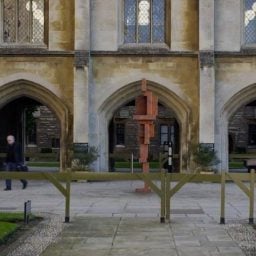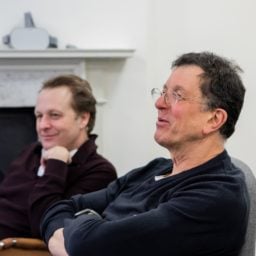Antony Gormley is understandably concerned about his carbon footprint, he confessed to the Times of London newspaper recently.
The British sculptor’s epic survey at the Royal Academy of Arts in London probably caused a bit of a carbon-emissions spike, he understands, with the walls and floors of the RA’s main gallery reinforced for his monumental new works made of steel (98 percent of it is recycled).
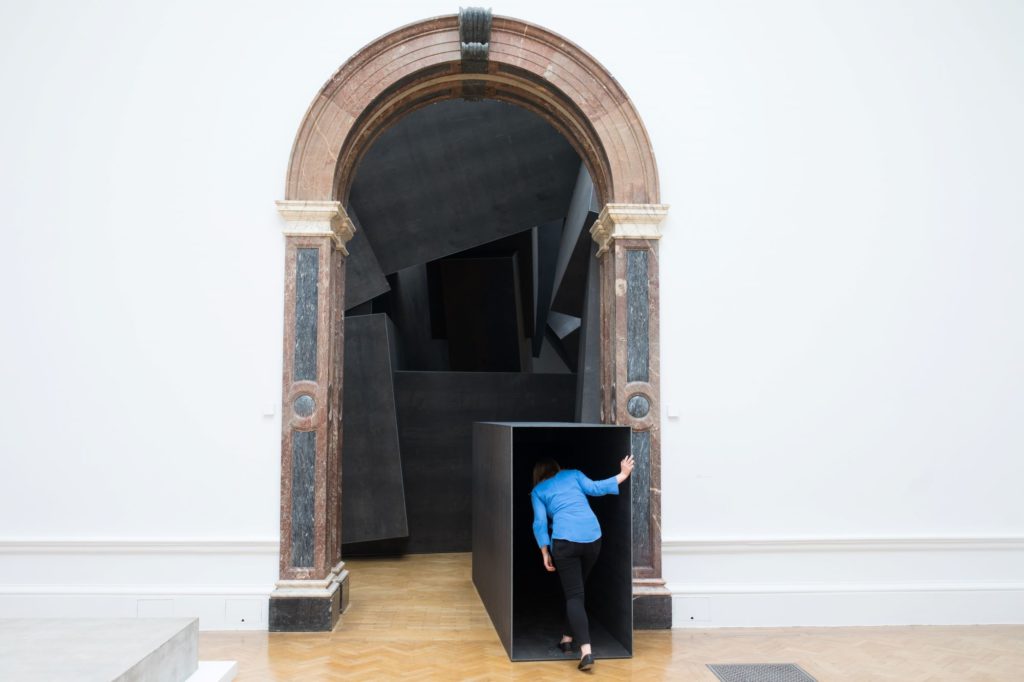
A visitor enters Antony Gormley’s Cave (2019) at the Royal Academy of Arts. © the Artist. Photo: David Parry.
The scale of the show makes sense, because the stakes are high. “He is definitely aware that he is following [exhibitions by] Anish Kapoor, Anselm Kiefer, Ai Weiwei,” says Martin Caiger-Smith, the show’s curator. Gormely “wouldn’t be a human being,” if he did not feel a bit of extra pressure. (Marina Abramovic, the first female artist to be honored by a solo show across all of the RA’s main galleries, is next up in 2020.)
Gormley, who became a Royal Academician in 2003, is best known for his epic outdoor works, but the exhibition underlines that in the great game of sculpture, he is an all-rounder. Simply titled “Antony Gormley,” the exhibition fills 13 rooms in every sense of the word. Showstoppers include Cave (2019), a new work on an architectural scale inspired by the artist’s visits to prehistoric cave art sites for a TV documentary. Visitors to the RA can explore the dark and winding tunnel, which is made from 27 tons of steel (the faint-hearted can squeeze around its edges).
In the biggest room, viewers can stand beneath six tons of steel-reinforcing mesh suspended from the ceiling. The site-specific sculpture, Matrix III (2019), has an inner core resembling, in size and shape, a typical bedroom, a reference to the fact that half the world’s population now lives within an urban jungle or grid.
Elsewhere, visitors have to duck and dive to get past the latest iteration of Clearing, a looping aluminium tube almost five miles long that almost completely fills one room. The show also includes a new iteration of Host (2019), a room filled with clay and flooded with seawater, its murky surface reflecting gilded details and skylight.
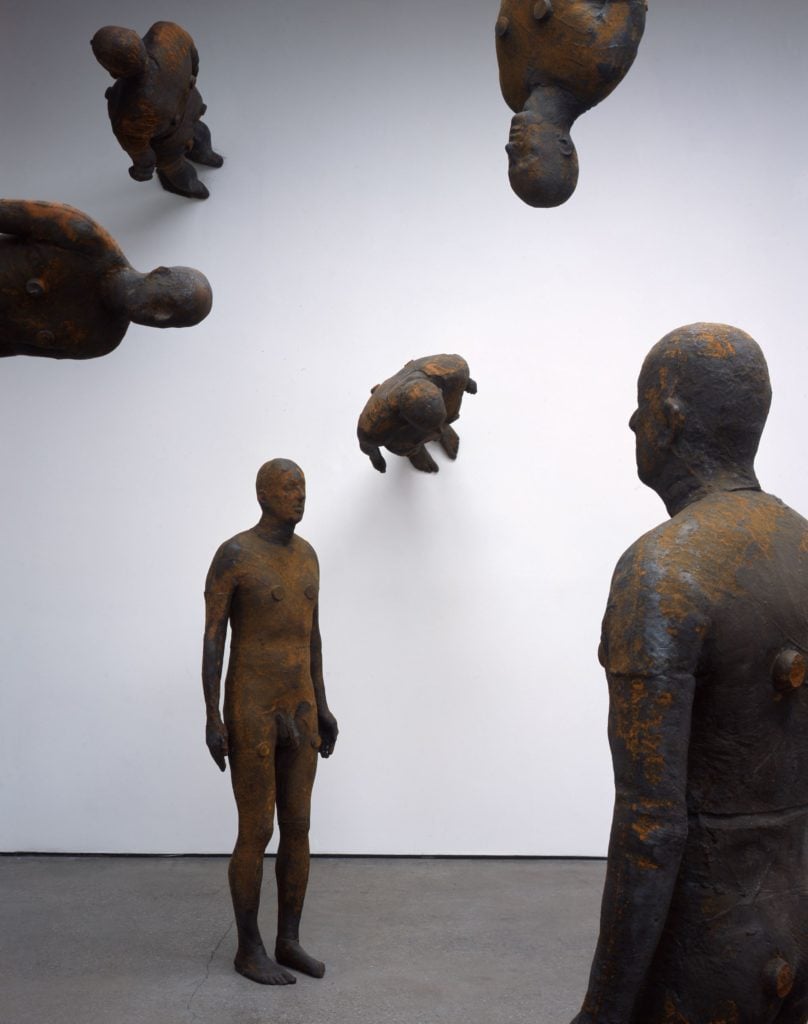
Antony Gormley Lost Horizon I (2008). © the Artist. Photo: Stephen. White, London
In the three decades since Gormley first created Host, he has become a one-man regeneration business. He commissioned a David Chipperfield-designed studio near King’s Cross station in North London when the area was still a twilight zone (Google’s London headquarters is now around the corner). Twenty-five studio assistants now work with the artist, who even bought the iron foundry he had worked with for years in the Northeast of England when the business was on the brink of closing. That added another 20 staff members to his team.
So the RA show is appropriately big. But as far as major exhibitions go, this one is probably less hard on the environment than most. Lost Horizon I (2008) did make the trip from billionaire Victor Pinchuk’s Kiev-based art foundation, and some other concrete works dating from the early 1990s were shipped from other private collections. But there are fewer long distance shipments than you might expect. The clay for Host comes from the Home Counties just beyond London, and the seawater was shipped from Dorset on the South Coast of England. Matrix III was welded together in London.
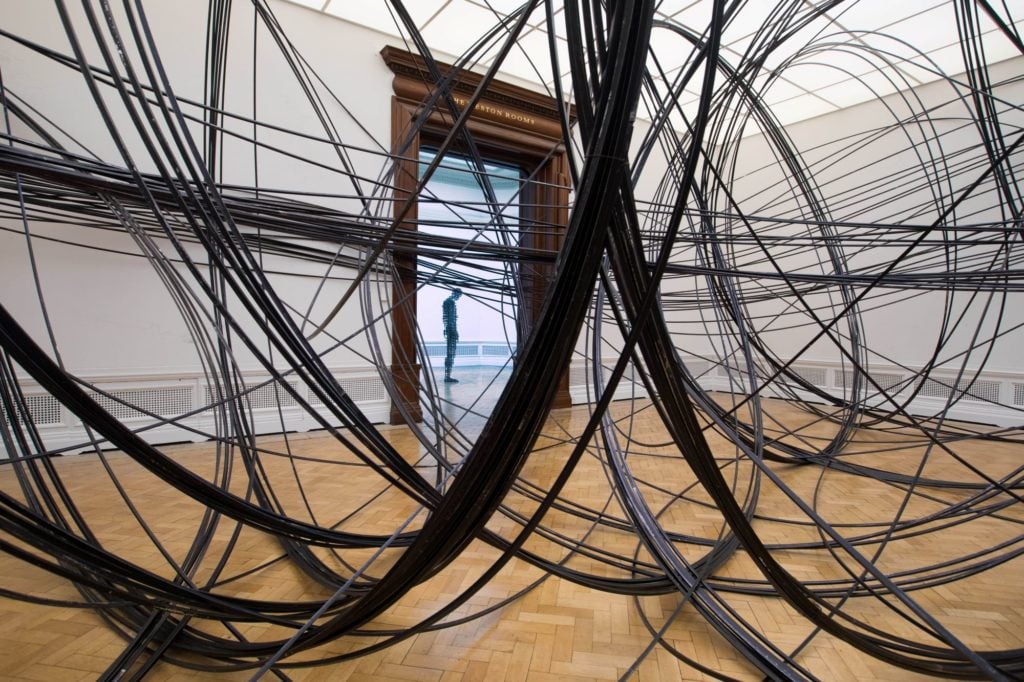
Antony Gormley, Clearing VII (2019) at the Royal Academy of Arts. © the Artist. Photo: David Parry.
Gormley’s monumental works, and his signature, cast-iron bodies, can at times feel relentless, but Caiger-Smith has created a sense of variety by changing the pace of the show to include more modest, early works. He has also filled vitrines with the artist’s “workbooks” that are full of ideas for works. Some of them, such as Angel of the North, the landmark in the North of England that cemented his reputation 20 years ago, have been realized. Others show ideas for sculptures that might one day loom over some city or landscape. (One intriguing sketch shows a string of giant spheres bridging an urban highway.)
Among a presentation of early works made from materials such as lead, slices of bread, and a blanket, Gormley has recreated a delicate wall drawing in red chalk. The lightest and certainly the most colorful work in the RA show, it originally dates from 1979. In 1981, it formed part of the artist’s first significant solo museum show, at the Whitechapel Gallery, where the curator was none other than a young Nicholas Serota.
The drawing, titled Exercise Between Blood and Earth, looks like a giant’s fingerprint, although its maximum dimension was dictated by how far Gormley’s (admittedly long arms) could reach while he stood stationary. It is about the body as an energy field, Caiger-Smith says. And as he nears his 70th birthday, Gormley shows no signs of resting or slowing down. Far from a retrospective, this feels more like a super-charged, mid-career survey.
“Antony Gormley” is on view at the Royal Academy of Arts, London, from September 21 through December 3.






